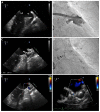Transient Left Atrial Appendage Inversion During Transcatheter Closure Device Placement
- PMID: 32435336
- PMCID: PMC7237096
- DOI: 10.4022/jafib.2211
Transient Left Atrial Appendage Inversion During Transcatheter Closure Device Placement
Abstract
A 72-year-old female patient underwent left atrial appendage closure. During recapture of the occlusion device, transient inversion of the appendageal wall occurred. We describe the mechanism with real-time imaging and share our experience of handling this situation. To the best of our knowledge, this is the first case report of this unique recapture complication.
Keywords: Left atrial appendage inversion; atrial fibrillation; transcatheter closure.
Figures



References
-
- Reddy Vivek Y, Holmes David, Doshi Shephal K, Neuzil Petr, Kar Saibal. Safety of percutaneous left atrial appendage closure: results from the Watchman Left Atrial Appendage System for Embolic Protection in Patients with AF (PROTECT AF) clinical trial and the Continued Access Registry. Circulation. 2011 Feb 01;123 (4):417–24. - PubMed
-
- Holmes David R, Kar Saibal, Price Matthew J, Whisenant Brian, Sievert Horst, Doshi Shephal K, Huber Kenneth, Reddy Vivek Y. Prospective randomized evaluation of the Watchman Left Atrial Appendage Closure device in patients with atrial fibrillation versus long-term warfarin therapy: the PREVAIL trial. J. Am. Coll. Cardiol. 2014 Jul 08;64 (1):1–12. - PubMed
-
- Möbius-Winkler Sven, Majunke Nicolas, Sandri Marcus, Mangner Norman, Linke Axel, Stone Gregg W, Dähnert Ingo, Schuler Gerhard, Sick Peter B. Percutaneous left atrial appendage closure: Technical aspects and prevention of periprocedural complications with the watchman device. World J Cardiol. 2015 Feb 26;7 (2):65–75. - PMC - PubMed
-
- Aronson S, Ruo W, Sand M. Inverted left atrial appendage appearing as a left atrial mass with transesophageal echocardiography during cardiac surgery. Anesthesiology. 1992 Jun;76 (6):1054–5. - PubMed
-
- Minich L L, Hawkins J A, Tani L Y, Judd V E, McGough E C. Inverted left atrial appendage presenting as an unusual left atrial mass. J Am Soc Echocardiogr. 1995 May 1;8 (3):328–30. - PubMed
Publication types
LinkOut - more resources
Full Text Sources
